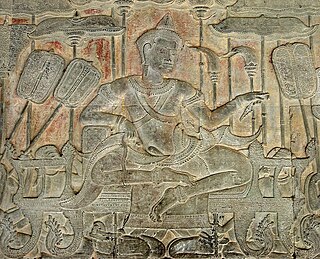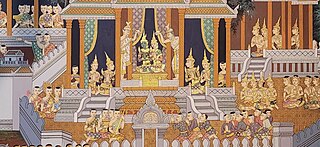
Khmer architecture,also known as Angkorian architecture,is the architecture produced by the Khmers during the Angkor period of the Khmer Empire from approximately the later half of the 8th century CE to the first half of the 15th century CE.

Angkor,also known as Yasodharapura,was the capital city of the Khmer Empire,located in present-day Cambodia. The city and empire flourished from approximately the 9th to the 15th centuries. The city houses the Angkor Wat,one of Cambodia's most popular tourist attractions.

Apsaras are a member of a class of celestial beings in Hindu and Buddhist culture. They were originally a type of female spirit of the clouds and waters,but,later play the role of a "nymph" or "fairy". They figure prominently in the sculptures,dance,literature and paintings of many South Asian and Southeast Asian cultures.

Angkor Wat is a Hindu-Buddhist temple complex in Cambodia. Located on a site measuring 162.6 hectares within the ancient Khmer capital city of Angkor,it is considered the largest religious structure in the world by Guinness World Records. Originally constructed in 1150 CE as a Hindu temple dedicated to the deity Vishnu,it was gradually transformed into a Buddhist temple towards the end of the century.

The Khmer Empire was a Hindu-Buddhist empire in Southeast Asia,centered around hydraulic cities in what is now northern Cambodia. Known as Kambuja by its inhabitants,it grew out of the former civilisation of Chenla and lasted from 802 to 1431. Historians call this period of Cambodian history the Angkor period,after the empire's most well-known capital,Angkor. The Khmer Empire ruled or vassalised most of mainland Southeast Asia and stretched as far north as southern China. At its peak,the Empire was larger than the Byzantine Empire,which existed around the same time.

The Bayon ( BAI-on) is a richly decorated Khmer temple related to Buddhism at Angkor in Cambodia. Built in the late 12th or early 13th century as the state temple of the King Jayavarman VII,the Bayon stands at the centre of Jayavarman's capital,Angkor Thom.

Banteay Kdei,also known as "Citadel of Monks' cells",is a Buddhist temple in Angkor,Cambodia. It is located southeast of Ta Prohm and east of Angkor Thom. Built in the mid-12th to early 13th centuries AD during the reign of Jayavarman VII,it is in the Bayon architectural style,similar in plan to Ta Prohm and Preah Khan,but less complex and smaller. Its structures are contained within two successive enclosure walls,and consist of two concentric galleries from which emerge towers,preceded to the east by a cloister.

Ta Som is a small temple at Angkor,Cambodia,built at the end of the 12th century for King Jayavarman VII. It is located north east of Angkor Thom and just east of Neak Pean. The King dedicated the temple to his father Dharanindravarman II (Paramanishkalapada) who was King of the Khmer Empire from 1150 to 1160. The temple consists of a single shrine located on one level and surrounded by enclosure laterite walls. Like the nearby Preah Khan and Ta Prohm the temple was left largely unrestored,with numerous trees and other vegetation growing among the ruins. In 1998,the World Monuments Fund (WMF) added the temple to their restoration program and began work to stabilise the structure to make it safer for visitors.

Banteay Srei is a 10th century CE Cambodian temple dedicated to the Hindu god Shiva and Parvati. Located in the area of Angkor,it lies near the hill of Phnom Dei,25 km (16 mi) north-east of the main group of temples that once belonged to the medieval capitals of Yaśodharapura and Angkor Thom. Banteay Srei is built largely of red sandstone,a medium that lends itself to the elaborate decorative wall carvings which are still observable today. The buildings themselves are miniature in scale,unusually so when measured by the standards of Angkorian construction. These factors have made the temple extremely popular with tourists,and have led to its being widely praised as the jewel of Khmer art.

Suryavarman II,posthumously named Paramavishnuloka,was the ruler of the Khmer Empire from 1113 until his death in 1150. He is most famously known as the builder of Angkor Wat,the largest Hindu temple in the world,which he dedicated to Vishnu. His reign's monumental architecture,numerous military campaigns and restoration of strong government have led historians to rank Suryavarman II as one of the empire's greatest rulers.

Dance in Cambodia consists of three main categories:classical dance of the royal court,folk dance which portrays cultural traditions,and social dances performed in social gatherings.

The Royal Ballet of Cambodia is a classical Khmer dance known for its intricate hand movements and elaborate costumes. Historically linked to the Khmer court,it has been performed at various royal ceremonies such as coronations,weddings,funerals,and Khmer holidays. The repertoire includes various ancient Khmer legends.

Preah Palilay is a temple at Angkor,Cambodia. It is located in Angkor Thom,400 m north-west of Phimeanakas. This small Buddhist sanctuary in the wooded area north of the Royal palace in Angkor Thom has a number of attractive features and is well worth the short detour.

Siem Reap is the second-largest city of Cambodia,as well as the capital and largest city of Siem Reap Province in northwestern Cambodia.

Khmer traditional clothing refers to the traditional styles of dress worn by the Khmer people throughout history. Tracing their origins back to the early Common Era,the customary styles of dress worn by Khmer people predate the indianization of Southeast Asia. The evolution of these clothing customs can be traced through archaeological artifacts from the 6th century to the post-Angkorian period,evolving from the simple pre-Angkorian Sampot to vibrant and intricately embroidered silk garments.

Prasat Suor Prat is a series of twelve towers spanning north to south lining the eastern side of a royal square in Angkor Thom,near the town of Siem Reap,Cambodia. The towers are made from rugged laterite and sandstone. They are right in front of Terrace of the Elephants and Terrace of the Leper King,flanking the start of the road leading east to the Victory Gate,on either side of which they are symmetrically arranged. Their function remains unknown.

Robam Tep Apsara is one of the traditional dances of the Royal Ballet of Cambodia repertoire. It is played by women,sewn into tight-fitting traditional dress,whose graceful,sinuous gestures are codified to narrate classical myths or religious stories. It is one of the national symbols of Cambodia.
Angkor Village Hotel is a hotel in the central Old French Colonial Quarters of Wat Bo district in Siem Reap,Cambodia. It was opened in 1994,is classified as member of Small Luxury Hotels of the World,and offers swimming pool,the a la carte restaurant L’Auberge des Temples,Siem Reaps oldest theater,the Angkor Village Apsara Theatre,and wellness options as a spa centre.
Tep Vattho was an architect,hotel owner,urban planner and director of the urban planning department of the Apsara Authority in Siem Reap,Cambodia.

David-Jaya Piot,born 23 August 1996 in Siem Reap,is a French-Cambodian hotelier in Cambodia,president of Siem Reap Chapter of Cambodia Hotel Association. He is co-owner and managing director of the family enterprises Angkor Village Hotel,Angkor Village Apsara Theatre and co-founder of the elephant retirement park Kulen Elephant Forest.


















